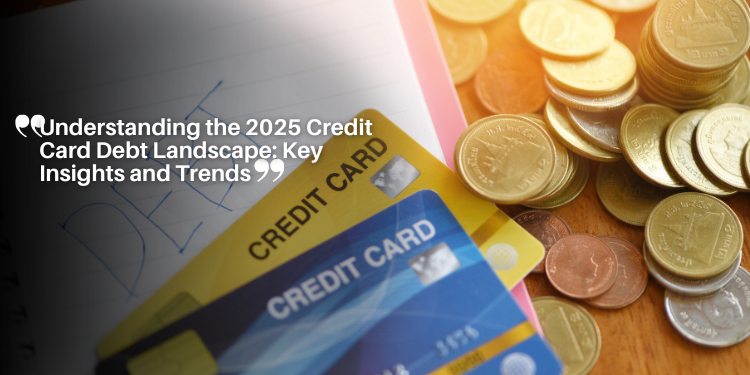Understanding the 2025 Credit Card Debt Landscape: Key Insights and Trends

An In-Depth Look at Americans’ Credit Card Use, Debt Levels, and Economic Impact
Overview of 2025 Credit Card Debt Statistics
The credit card debt statistics presented here reflect the evolving financial behavior of American consumers.
Regularly updated, this page tracks the average debt held by Americans, the frequency of balance carryovers, late payments, and other significant trends.
These insights serve as a crucial guide for understanding the financial pressures many Americans are facing and the broader economic impact.

How Much Credit Card Debt Do Americans Have?
As of the fourth quarter of 2024, the total credit card balance in the United States reached a staggering $1.211 trillion, marking the highest recorded amount since the Federal Reserve Bank of New York began tracking consumer debt in 1999.
This figure represents a notable increase from $1.166 trillion in Q3 2024, reflecting a consistent rise in credit card balances.
Over the past 11 quarters, credit card debt has either increased or remained steady in 10 of those quarters.
The lone exception was in Q1 2024, where a slight decline was observed. It is not uncommon for credit card debt to drop in Q1, with historical data showing decreases in most years, except for a few years such as 2000, 2001, and 2023.
Notably, the decline in Q4 2009 and 2010 during the Great Recession was a rare event.
Despite the challenges posed by the pandemic, credit card debt has shown no signs of dropping in the last quarter of any year since the recession.
From Q1 2021, when the debt dipped to $770 billion, to Q4 2024, credit card balances have surged by $441 billion, marking a 57% increase in under four years.
This sharp increase is more than $284 billion above the pre-pandemic high of $927 billion in Q4 2019, reflecting a 31% rise.
Factors such as high-interest rates, persistent inflation, and economic uncertainties are likely to contribute to the continuing upward trajectory of credit card balances.
These current balances are far beyond the $478 billion seen in Q1 1999, highlighting the significant growth over the past two decades.
The history of credit card debt shows a significant “hockey stick” growth pattern. Before the financial collapse in 2008, balances grew steadily from $866 billion in Q4 2008 to $660 billion by Q1 2013.
However, after the pandemic took hold in 2020, balances fell briefly from $927 billion to $770 billion in Q1 2021 before another sharp increase took place, particularly evident in Q4 2021.
State-Level Credit Card Debt Variations
Which states have the most credit card debt?
The distribution of credit card debt varies widely across different states, with New Jersey residents holding the highest average credit card debt, according to data from LendingTree.
Conversely, Mississippi residents report the lowest average balances.
In an analysis of anonymized credit reports from over 400,000 LendingTree users in Q1 2025, the average national credit card balance among cardholders with unpaid balances stood at $7,321, marking a 5.8% increase from the previous year’s average of $6,921 in Q1 2024.
This includes both bank-issued credit cards and retail store credit cards.
Several states, notably in the Northeast and West, saw average credit card debt exceed $9,000.
New Jersey tops this list with an average balance of $9,382, followed by Maryland ($9,252) and Connecticut ($9,201).
Other states, including Massachusetts, California, and Florida, follow closely behind.
Conversely, the states with the lowest credit card balances are predominantly in the South.
Mississippi leads with the lowest average balance of $5,221, slightly lower than Kentucky ($5,237) and Arkansas ($5,245).
Fastest-growing credit card debt:
Georgia reported the largest increase in credit card balances, with an alarming 20.5% increase from Q1 2024 to Q1 2025, from $6,592 to $7,943.
Several other states experienced significant increases as well, with Oklahoma seeing a 14.9% rise and Massachusetts and the District of Columbia both growing by 13.3%.
Where are credit card balances decreasing?
In contrast, Louisiana saw the most notable decrease in credit card balances, with a 8.4% drop, from $5,835 to $5,342.
Other states, such as North Dakota and Iowa, also experienced reductions in credit card debt, with declines of 5.7% and 5.2%, respectively.
Credit Card Balance Carrying Trends
What percentage of credit cardholders carry a balance?
According to a Federal Reserve study conducted in May 2024, fewer than half of adult credit cardholders (47%) carried a balance on their cards for at least one month during the previous year.
The ideal situation for any credit cardholder is to pay off the entire balance at the end of each month, avoiding the accrual of interest.
However, due to the challenges of daily life, many consumers are unable to pay off their balances in full.
While this percentage dropped from 50% in 2020 to 47% in 2023, the rate remains relatively high, reflecting ongoing financial difficulties for many Americans.
| Credit Card Type | Average APR | Comparison |
|---|---|---|
| 📊 All Credit Cards | 21.37% (Q1 2025) | Decrease from 21.47% (Q4 2024) |
| 💳 Credit Cards Carrying Balance | 21.91% (Q1 2025) | Decrease from 22.80% (Q4 2024) |
| 🆕 New Credit Card Offers | 24.28% (Q1 2025) | Highest since December 2024 |
Delinquency and Default Rates
How many Americans are currently delinquent on their credit card payments?
As of the most recent data, 3.08% of all outstanding credit card balances in the United States are at least 30 days delinquent.
This indicates a decrease from the previous quarter’s rate of 3.20%. Although the drop of 0.12 percentage points is notable, it remains within a historically low range.
This is the second decrease in delinquency rates following 11 consecutive quarters of increases, highlighting a more stable financial environment for many credit cardholders.
Despite the improvement, delinquency rates remain below historical averages, with the long-term average standing at 3.72% since the Fed began tracking in 1991.
During the Great Recession, delinquency rates surged to nearly 7% but have since remained significantly lower.
Conclusion
While credit card balances have surged to record levels, the delinquency rate has shown signs of stabilization.
However, high-interest rates and economic uncertainties suggest that many consumers will continue to face financial challenges in the coming months.
The increase in credit card debt, particularly in certain states, underscores the need for financial education and better debt management strategies.
By paying attention to these trends and taking proactive steps, Americans can improve their financial stability, reduce their debt, and mitigate the long-term effects of high credit card balances.







